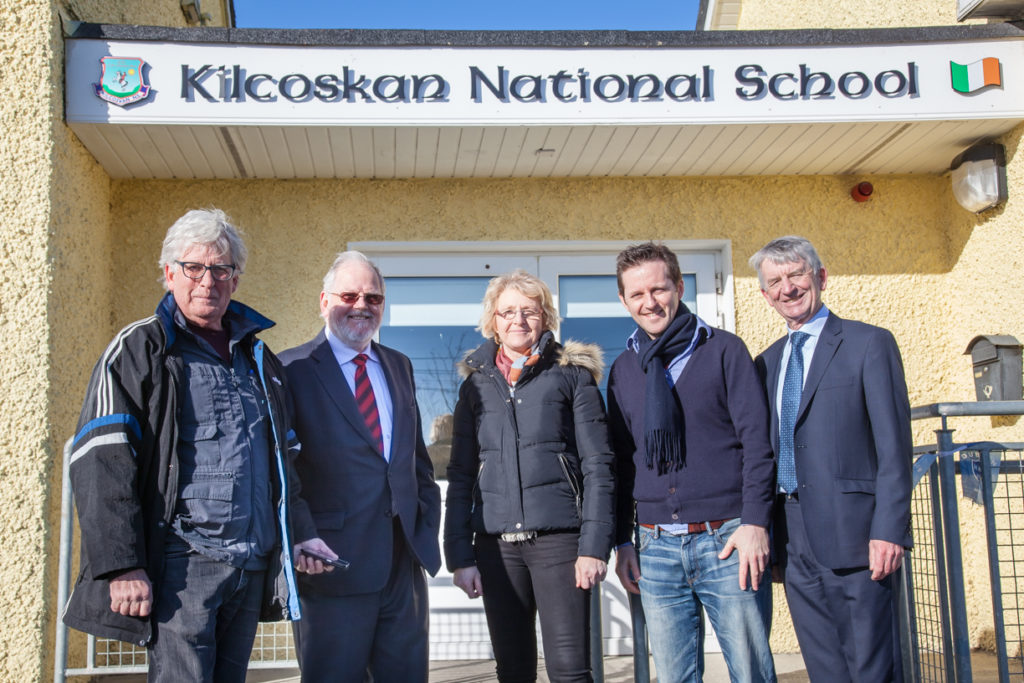[et_pb_section fb_built=”1″ _builder_version=”3.0.47″][et_pb_row _builder_version=”3.0.47″ background_size=”initial” background_position=”top_left” background_repeat=”repeat” _i=”0″ _address=”0.0″][et_pb_column type=”4_4″ _builder_version=”3.0.47″ parallax=”off” parallax_method=”on”][et_pb_text _builder_version=”3.0.76″]
A growing number of primary schools in the Swords area are now part of the “Grow A Native Locally” biodiversity project promoted by the Swords Woodland Association,The students learn about many factors related to woodlands, including lessons in how trees absorb and store carbon. The Swords Woodland project was provided free of charge to a few local schools as generous funding has been provided by the Community Fund of Dublin Airport Authority and Fingal County Council.
students at Kilcoskan National School were taking a good look at the box used to plant the seeds with School Principal, Ciarán Caulfield, and the Kilcoskan garden projects supervisor, Grainne.
The timber surround that houses the dunemann bed was suppleid to the schools by the Swords Woodland Association. Visiting the school on the day were three members of this new advocacy group, Myles Caulfield (Secretary), Councillor Joe Newman and the project lead Edward Stevenson. The School’s venture was started in mid –December and everyone was pleased to see that all was going to plan.
Ciarán Caulfield explained how the new biodiversity venture ties in well with some other features at the school.
“The school expanded a few years ago and we had to totally re-arrange our outdoor activities. We came together as a school community and everyone agreed to save a bit of space to make a garden feature. It’s turned out well and we now have two trails with plants from just about every continent and further on it becomes what we call our meadow trail. While it is a small space we also manage to have a vegetable planter for each class. We have fruiting trees and berries on the perimeter. We have lots of other new and interesting plans to take on over the coming years.
We found out about the Swords Woodland Association tree project through one of our teachers Trish and we were really pleased to see how the box ussed to plant the seeds was durable and very attractive. It fits in really well our other biodiversity projects.
[/et_pb_text][et_pb_image src=”http://www.joenewman.ie/wp-content/uploads/2018/02/SWA_Kilcoskan_NS-5-1.jpg” _builder_version=”3.0.76″][/et_pb_image][et_pb_text _builder_version=”3.0.76″]
Some of the school garden squad with Councillor Joe Newman. Myles Caulfield Sec.Swords Woodland Association. Kilcoskan garden projects supervisor, Grainne. Principal Ciaran Caulfield. Edward Stephenson project lead and education officer Swords Woodland Association.
[/et_pb_text][et_pb_divider height=”20px” _builder_version=”3.0.76″][/et_pb_divider][et_pb_text _builder_version=”3.0.76″]
The Dunemann bed project is based on folk knowledge employed by a German forestry consultant who was invited to Ireland very early in the last century. It is also known as the “copy nature system” because the seeds are planted in leaf mulch that has been generated by the trees from which the seed has propagated. This allows the seed to begin germination front-loaded with the Organic and DNA components of the “mother tree”.
Current research from the past few decades has verified this design. A key part of the process is the presence of trace elements in the decomposing leaf associated with fungi. The new research has been able to track the “chemical language” that trees share with an immense system of organisms that live beneath the forest floor unseen by us. The health of what is called the forest understory is now known to be critical to how a forest habitat sustains itself. The inter-dependencies, now better understood, will help to sustain diverse habitat and improve woodland systems.
“We will continue to look for new ideas and try hard to make this a genuine space for learning that offers fun and enjoyment at the same time”, concludes Ciarán. “The significant benefits of maintaining links to the natural environment are indisputable. These green projects in our garden space offer the children a lot of positives”.
[/et_pb_text][/et_pb_column][/et_pb_row][/et_pb_section]
